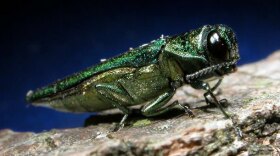Agriculture officials are introducing stingless, parasitic wasps from Asia in an effort to control another non-native insect – the Emerald Ash Borer.
The tiny wasps (Tetrastichus Planipennisi) are a natural parasite of the invasive beetle, native to Asia,that has decimated the ash tree population across the U.S. EAB was found in the city of Boulder in 2013, the furthest west it has yet been found.
"If we run out of the wasp won't survive either," said John Kaltenbach, a biological control specialist with the state department of agriculture.
"There's definitely an ecological balance we look at for long term sustained control. Then we would still have ash trees in the Boulder area," he said.
The wasps pose no threat to people or pets and are raised in a lab in Michigan.
According to a press release, the USDA initiated a biological control effort shortly after EAB was initially detected in Michigan in 2002. "Today the EAB Biological Control Production Facility is rearing the wasps for release, and since 2007, one or more parasitic wasp species have been released in 18 of 24 states where EAB has been confirmed," the press release continued.
The adult wasps are about the size of gnat. They lay roughly 100 eggs in each of the inch-long EAB larvae, killing them before they reach adulthood.

The lab has shipped a tree branch that has parasitized EAB larvae underneath the bark, which will be placed on the east University of Colorado Boulder campus, where EAB has been found. The hope is the wasps will hatch and go after the other EAB in the area.
Kaltenbach said it's unlikely that the wasps will become a permanent part of Colorado's environment, although they can survive Colorado's winters.
"The negative implications of the stingless wasp release is if it attacked another species similar to EAB, but we really don't have too many of those and it is very host specific, it really likes EAB over everything else, so we're not very concerned about that," he said.
For agriculture officials, the threat of to the urban tree canopy is of grave concern.
"The ecological effects of EAB are huge," Kaltenbach said. "We're talking 15 percent of our urban trees are ash trees. So if we lose that that's 15 percent of our urban tree canopy. That has a huge effect. So that's our future here. This is a way to maybe keep that at bay a little bit, save some of our tree canopy which is very important."





